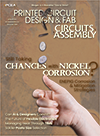Book Reviews
Electronic Packaging and Interconnection Handbook, 3rd Edition
 By Charles A Harper
By Charles A Harper
McGraw Hill
14 Chapters, terms,
abbreviations and over 600 pages with references for each chapter
Charles Harper is a common fixture at the major electronics events and continues to be involved in the fast moving electronics assembly industry through his company, Technology Seminars. Charles has edited or authored ten books in the field of electronics, but is best known for this handbook.
The third edition of this interconnection bible, features many well recognized experts and the chapters cover each aspect of printed circuit board (PCB) manufacturing, assembly and equipment design processes. The less fashionable areas, such as connectors, wire terminations and hybrids are also covered with updates from the previous issues of the handbook.
Of particular interest are the chapters on PCB technology that illustrate the basics of fabrications for plated through hole of double, multilayer, flexible circuits and current trends in microvia techniques. Omissions include the important issues of solder finishes and the overall future production processes.
One chapter is devoted to surface-mount technology, much of which focuses on the use of ball grid arrays (BGAs). Useful advice is given on each of the manufacturing techniques such as printing and placement with advice on x-ray inspection and process defects.
A chapter by Joseph Fjelstad, on chip scale packages (CSPs) and direct mounting of die to the boards, is very interesting and extremely well illustrated. The use of CSPs is on a growth curve and provides many of the advantages that direct flip chip cannot. Joe has highlighted specific issues related to the manufacturing techniques for the components. The chapter could have benefited by a small section on PCB design for the use of these parts.
Jennie Hwang contributes a section devoted to soldering technology with a small section on lead-free. The topic of lead-free will be covered in more detail when she releases her new book devoted to environmentally friendly assembly in a couple of months.
Overall, the book offers references that should suit all engineers who need a general book on up-to-date technology.
Press Releases
- NEOTech Significantly Improves Wire Bond Pull Test Process
- Sat Nusapersada Chooses Siemens' Process Preparation Software to Boost NPI and SMT Line Efficiency
- SIA Praises Finalization of CHIPS Investments for GlobalFoundries Manufacturing Projects
- KYZEN to Spotlight KYZEN E5631, AQUANOX A4618 and Process Control at SMTA Silicon Valley Expo and Tech Forum







